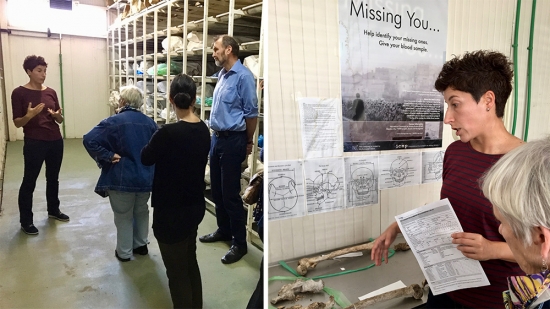Tuzla and home
The Podrinje Identification Project facility
We made the 3 hour journey back from Srebrenica to Tuzla and arrived just after lunch at the Podrinje Identification Project facility.
We attended a meeting with forensic anthropologist Dr Dragana Vucetic based at a special facility in Tuzla that works to reunite human remains with their families through DNA and other analysis. Here, we were taken to a large cold store that contained shelf after shelf of human remains. I have never really contemplated what death might smell like but if it were to have a smell, this room certainly held it.
Dr Vucetic told us that following the conflict, through testimony of witnesses and sometimes by accident, mass graves have been uncovered. She also explained that it is believed that mass graves were dug up and moved by the perpetrators to avoid detection. This has meant that the bones of some individuals have ended up in several locations. Additionally, because of burial and deterioration in the time since the conflict, identification is not easy. For this reason, her facility was funded to try and reunite as many finds with their families as possible. The facility relies on families who have lost loved ones coming forward with a DNA sample so that they can attempt to match finds to it. In the earlier years of the project, Dr Vucetic explains that they were able to match and identify sometimes hundreds of individuals in a year, but as the years go by, the number matched is becoming fewer and fewer. There are also a large number of remains sitting in their cold store who are yet to be identified because the family may have never come forward and given a DNA sample.
Sometimes, all that the facility is able to offer families is a single bone that has been found and matched. Dr Vucetic explains that it is believed that this is due either to graves being disturbed by animals or having been moved, which accounts for the fact that some individuals’ bones have been found in two or three locations. Well over 6000 bodies have now been returned, and as the new grave finds become fewer and further between, the facility will wrap up its work in the coming years.

The Tuzla facility. Photo credits: Ivan Deben Wells
Personal reflections on a region in slow recovery
Bosnia Herzegovina felt to me like a country in a region that is slowly healing from the actual wounds of the conflict but one which very much still bears the scars. The weapons may have been laid down over twenty years ago, but the cold war that exists is still everywhere to see – from the changes in road signs and places of worship between boundaries to the dysfunctional government and self-imposed ethnic segregation.
And of course, most importantly of all, there is the bitterness that still exists between all sides in the 1990s conflict, but particularly between those in Bosnia Herzegovina who recognise that crimes against humanity took place here and seek justice, and those who deny that any such thing took place and see Serbian actions in the area as necessary actions to reclaim what was taken centuries ago.
As we travelled to the airport to board our flight home, I couldn’t help but feel an overwhelming sense of sadness for the future of this beautiful region and what felt like the almost impossible task of complete rehabilitation. If ever there was a region that could easily teeter on the brink of conflict again, it felt like it could so easily happen here. I sincerely hope that it doesn’t.


